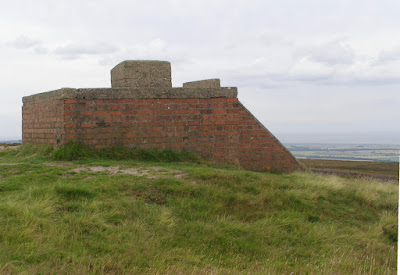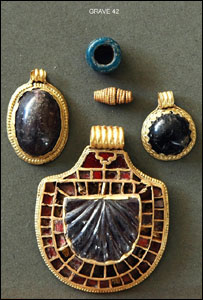
On the moors above Guisborough stands this brick and concrete bunker which, as children, we always referred to as the Troll's House. My father said that it was built during the Second World War to hold oil that was to be used to set the moors alight in order to distract German bombers from dropping their bombs on the nearby industrial town of Middlesbrough. Well, a little Googling reveals this to be approximately correct, but the full story is somewhat more exciting. Bob Hunt's Portsdown Tunnels web-site has a good introduction (apparently taken from an article by Fred Nash of Essex County Council):
In the autumn of 1940, the mass bombing of Britain's cities - and in particular the devastation wrought on Coventry - turned the attention of Colonel J F Turner's Air Ministry department to the possibility of providing decoys to divert the bombers away from large urban targets. What was needed was the replication, as far as was possible, of a city under incendiary attack. It needed fires on a truly legendary scale. And thus was born the fabled Starfish site, the largest, most sophisticated decoy built in the war.
Within days of the raid on Coventry on the night of 14/15 November, work started on the construction of these huge fire-based decoys around Britain's major towns and cities. From Southampton to Glasgow, from Birmingham to Crewe, tons of wood, and indeed anything combustible, was gathered to make improvised bonfires to try and draw some of the bombers away from the centres of population. But although immediately successful in some places, notably Bristol, Derby and Sheffield, these makeshift fire arrangements needed to be improved to guarantee a long-lasting effect with different kinds of fire to give a realistic variety of colour and intensity. If the Luftwaffe bomber pilots were to be deceived into thinking they were attacking a blazing town, the effects needed to be dramatic, varied and sustainable.
Tests and experiments followed. Using steel tanks, troughs, pipes and grids, fuel could be made to pour, spray or trickle at timed intervals. Different kinds of flammable materials, variously soaked with boiling oil, paraffin or creosote, could create the random fire effects of burning houses, factories and power stations. Finally, four kinds of fire source which could be "manufactured" were decided upon, and construction work began.
There is also some interesting material on Starfish sites and other types of decoy sites by Huby Fairhead at the Norfolk and Suffolk Aviation Museum.
It was the design and construction of these simulations of burning towns and cities that was known as Project Starfish. I guess that the Guisborough Starfish site was one of the simple, first generation sites. Setting alight the heather moors would have been the obvious way to start a big fire quickly in the Middlesbrough area. However, my father says that the site was never used and the moors never were set alight, so either the German bombing of Middlesbrough wasn't as heavy as had been feared or else the site quickly became obsolete and was replaced by a more complex decoy somewhere else in the area (possibly a more easily accessible lowland site?). Another possibility was that, while the moors were not set alight, the site did use some of the more sophisticated pyrotechnic devices and that these were not as noticable from Guisborough. But this is really just speculation on my part.

This shows the view from the south with the North Sea in the distance. In this view, Middlesbrough is hidden behind the left end of the bunker, but there is no doubt that the occupants of the bunker would have been able to see clearly if Middlesbrough was ablaze. [Note added 2007-09-18: Middlesbrough itself would be hidden by the Eston Hills, but the glow would still be visible.]

This shows the main entrance which, originally, would have had a blast wall immediately in front of it. The blast wall, together with part of the sloping wall to the right of the door, may have been demolished to provide rubble for repairing the nearby Kildale Road.

And this is a view from the north taken by my father. It was seeing this photo on his Flickr site a few months ago that renewed my interest in the history of this building.
According to Huby Fairhead, Project Starfish was considered a great success:
The decoy towns were bombed about 100 times, drawing some 5% of the bombs intended for towns and cities. Official figures declared that Decoy Sites saved an estimated 2,500 lives and avoided 3,000 injuries; four civilians were killed through raids on decoy sites. These 1946 figures seem to be on the low side. It should be noted that, in most case, only bombs dropped on sites could be counted as being “dropped on the decoy”. After the war, however, it was agreed that bombs dropped within two miles of a site should have been counted to allow for inaccuracies due to Anti-Aircraft fire, fighter aircraft, weather conditions or poor bomb-aiming and navigation.
You can find Starfish decoy bunkers in other parts of the country. Here is one near Glasgow photographed by Russell W. Barnes, and here one at Kislyth (also in Scotland) photographed by Gordon 'The Historian'. I even seem to remember seeing something on a walk past Hardwick House near Mapledurham (just 4km from Reading) that I now realise could be one of these bunkers. Sometime soon, I will take a walk out that way to check it out. [Note added 2008-04-18: I eventually did. I doesnt look like a starfish site, just four air-raid shelters associated with the hall. See here for more details.]
For more wartime sites in and around Teesside see here.
Here is an article on a Starfish site at Arborfield near Reading.
 Sat 2007-11-24
Sat 2007-11-24 




